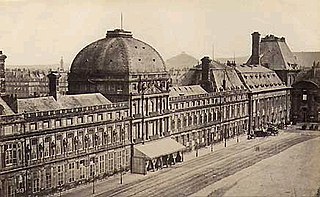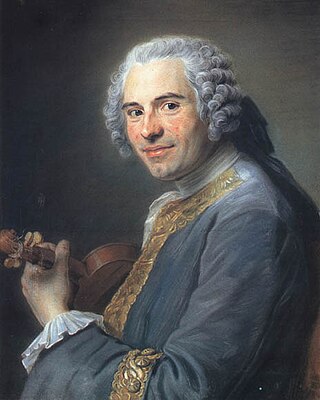
Dominique Joseph Garat was a French Basque writer, lawyer, journalist, philosopher and politician.

Jacques Pierre Joseph Rode was a French violinist and composer.

The Concert Spirituel was one of the first public concert series in existence. The concerts began in Paris in 1725 and ended in 1790. Later, concerts or series of concerts with the same name occurred in multiple places including Paris, Vienna, London and more. The series was founded to provide entertainment during the Easter fortnight and on religious holidays when the other spectacles were closed. The programs featured a mixture of sacred choral works and virtuosic instrumental pieces, and for many years took place in a magnificently-decorated Salle des Cent Suisses in the Tuileries Palace. They started at six o’clock in the evening and were primarily attended by well-to-do bourgeois, the lower aristocracy, and foreign visitors. In 1784 the concerts were moved to the stage area of the Salle des Machines, and in 1790, when the royal family was confined in the Tuileries, they took place in a Paris theater.

Jean-Joseph de Mondonville, also known as Jean-Joseph Cassanéa de Mondonville, was a French violinist and composer. He was a younger contemporary of Jean-Philippe Rameau and enjoyed great success in his day. Pierre-Louis Daquin claimed, "If I couldn't be Rameau, there's no one I would rather be than Mondonville".

Jan Václav Stich, better known as Giovanni Punto was a Czech horn player and a pioneer of the hand-stopping technique which allows natural horns to play a greater number of notes.

Johann Franz Xaver Sterkel was a German composer and pianist in the 18th and early 19th centuries.
Joseph Peyré was a French writer. He won the Prix Goncourt in 1935 for Sang et Lumières.
The Stabat Mater is a musical setting of the Stabat Mater sequence, composed by Luigi Boccherini in 1781 and revised in 1800.

Jean-Vital Jammes was a French opera singer. During a stage career spanning 40 years, he created many leading baritone roles, including Zurga in Bizet's Les pêcheurs de perles and Ourrias in Gounod's Mireille. Born in Le Passage d'Agen near the town of Agen, he was largely self-taught and made his stage debut in 1841 at the age of 16. After singing in several provincial theatres, he was engaged by the Théâtre Lyrique in Paris and later by the Opéra-Comique. Following his retirement from the stage, Ismaël lived in Marseille where he died at the age of 68.
Jean Veillot was a French composer and priest.
Jehan Chardavoine was a French Renaissance composer mostly active in Paris. He was one of the first known editors of popular chansons, and the author, according to musicologist Julien Tiersot, of "the only volume of monodic songs from the 16th century that has survived to our days."

Jean-Paul C. Montagnier is a French musicologist. He studied at the Conservatoire National Supérieur de Musique de Paris, where he received two first prizes in musical analysis and music history, before completing a PhD at Duke University under the supervision of Professor Peter Williams (1994). He is currently Professor of musicology at the University of Lorraine, and Associate Member of the Institut de Recherche en Musicologie (CNRS). He also was adjunct professor at McGill University (2007-2017). He was involved with Musica Gallica, an edition of the works of the musical patrimony of France (2000-2017). He was the secretary of the research program "Musical Life in Europe, 1600-1900: Circulation, Institutions, Representation" supported by the European Science Foundation (1998-2002), and the secretary (1994-2004), then the editor (2004) of the Revue de musicologie. He was a member of the editorial board of Eighteenth-Century Music published by Cambridge University Press (2002-2013). He currently serves on the editorial board of the Collected Works of Jean-Baptiste Lully published by Olms (Germany), and on the editorial board of the Revue belge de musicologie. He was made Officer in the Order of Arts and Letters by the French Government in 2012, and Chevalier in the Ordre National du Mérite in 2021. He was nominated to become a Robert M. Trotter Visiting Distinguished Professor at the University of Oregon School of Music and Dance during the 2018–2019 academic year.
Henri-Louis Blanchard was a French playwright, composer, violinist and music critic.

Stéphan Perreau is a French contemporary musician and art historian.

Brigitte François-Sappey is a French musicologist, educator, radio producer, and lecturer.

Jean de Bournonville was a French composer active in the first third of the 17th century, born in Noyon around 1585 and died in Paris on 27 May 1632. He should not be confused with his son Valentin de Bournonville, who published masses in the middle of the 17th century.
Annibal Gantez was a French composer and singer from the Baroque era. He is undoubtedly one of the most striking examples of a "vicarious" chapel master, that is, moving from post to post to earn a living, as many of his 17th century colleagues did. His route can be traced from two types of sources: letters from L'Entretien des musiciens, which he published in 1643, and various archival documents.

Louis-Augustin Richer was a French singer, singing professor and composer. He was a member of a family of musicians from Versailles who also had close ties to the family of André Danican Philidor. He gained prominence as a singer at the courts of Louis XV and Louis XVI and also served as Maître de musique for the courts of the Duke of Chartres and the Duke of Bourbon. After the abolition of the monarchy during the French Revolution, Richer became a professor at the Paris Conservatory.

Jean-Joseph Bonaventure Laurens was regarded by some as a "universal spirit", as attested not only by his paintings, watercolours and lithographs, but also by his vocation as a musician, archeologist, geologist and theorist.
L’isle déserte is a 1779 opera comique by Franz Ignaz Beck to a libretto by the Comte d'Ossun after Metastasio's libretto l'isola disabitata of 1754, coincidentally reset in Italian by Haydn in the same year in the same year as Beck. The libretto had been translated into French already in 1759. Haydn also composed an entirely different singspiel version Die wüste Insel. The work was never performed during Beck's lifetime, and recorded for the first time only in 2021 with La Stagione Frankfurt.













